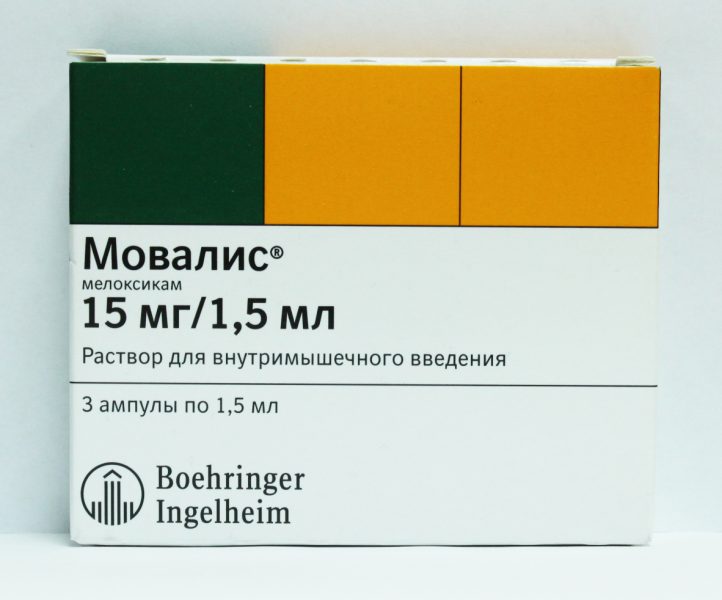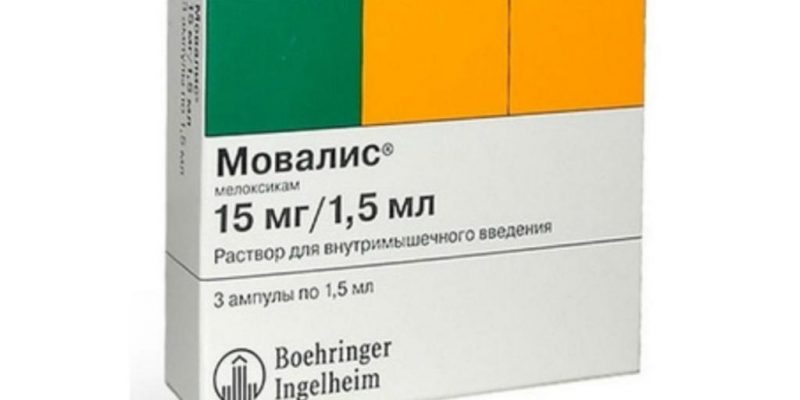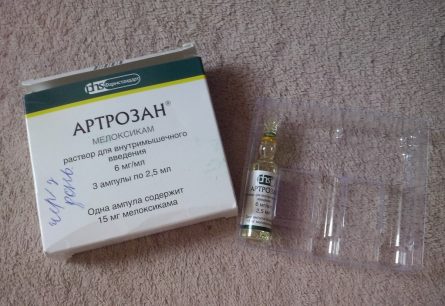The instruction for the use of injections of Movalis characterizes the drug as one of the most effective means against inflammatory pain. The abstract indicates significant differences between this medication and the drugs included with it in the same pharmacological group.
Movalis gained an exceptional position due to its high selectivity - the ability to act only on a certain type of prostaglandins. Due to this quality, he quickly reaches the goal and to a lesser extent affects other organs and systems.
Material Content:
Composition, release form and packaging
Injections Movalis is a drug for intramuscular administration. The medicine is a transparent, homogeneous, without the presence of solid particles, lemon-colored solution that is poured into ampoules with a capacity of 2 ml.
 Ampoules are made of thin, colorless transparent glass. Each unit of production has a break line. A distinctive feature of the packaging are two horizontal labels of yellow and green, located just above the narrowing.
Ampoules are made of thin, colorless transparent glass. Each unit of production has a break line. A distinctive feature of the packaging are two horizontal labels of yellow and green, located just above the narrowing.
The ampoule is not completely filled with a medicinal solution. It contains only 1.5 ml of liquid. In this volume, 15 mg of the active substance is present, which bears the nonproprietary international name - meloxicam.
In addition to the main component, meglumine, furfural and poloxamer are added, which contribute to the dissolution of the main active substance in water.Movalis composition is diluted on a special purified injection liquid into which glycine and sodium salts are added to maintain a homogeneous structure.
The ampoules with the medicine are laid out on transparent plastic pallets and packaged in cardboard packs of three or five pieces. Each product packaging is accompanied by a paper annotation. Shelf life of the medicine is limited to five years.
Pharmacological properties and pharmacokinetics
Movalis is classified as non-steroidal, i.e. non-hormonal, anti-inflammatory drugs (NSAIDs). Its action is to suppress the inflammatory process. It follows that he is able to relieve pain and to some extent heat.
The mechanism of action of the substance is based on the suppression of enzymes (cyclooxygenase or COX), which activate the production of prostaglandins.
It is with the release of prostaglandins that inflammation and, accordingly, pain begins.
COX is present in many organs and tissues. But the types of this enzyme behave differently. Cyclooxygenase of the first type is involved almost constantly. She not only takes part in inflammatory processes, but also in reactions to support the body. For example, this enzyme is part of the mechanism of liver self-regulation and blood coagulation.
Type 2 cyclooxygenase is activated only under certain conditions. Any irritation contributes to its launch. Pharmacists have the task of learning to “turn off” this particular enzyme without affecting the COX of the first type, thereby not disrupting the course of natural processes.
Most NSAIDs act on both enzymes, which causes a lot of side effects. In this light, meloxicam has a significant advantage. He has a selective ability. To some extent acts on COX-1, but to a greater extent suppresses COX-2. Therefore, against the background of treatment, patients are less likely to experience a negative effect on other organs.
The drug is well absorbed and very slowly excreted. With intramuscular administration, adsorption reaches almost one hundred percent. The active substance is 99% combined with blood albumin. Half of the entire concentration is then found in the joint fluid.
A twofold decrease in activity is observed only after twenty hours. The breakdown of the compound occurs in the liver. The starting material is practically not detected in the elimination products. The entire volume of the administered compound is decomposed by the liver into inactive substances. Metabolites are utilized along with feces and urine.
What is prescribed Movalis in injections
Movalis in injections is prescribed to obtain a quick analgesic effect in cases where other forms of the drug for some reason are not suitable. Injections relieve joint and periarticular pain of various origins.
The cause of their occurrence should be inflammation. Concentrating in the joint fluid, meloxicam stops the development of the pathological process, preventing the further release of prostaglandins.
Arthrosis, arthritis, osteoarthritis, spondylitis can be examples of diseases in which Movalis injections are prescribed. The medicine is part of symptomatic therapy and is used only to relieve acute pain.
Instructions for use of the drug
Empirically, it turned out that the result of the use of the drug will depend on the dose. By the same principle, it was decided that the optimum amount of compound for one injection is 7.5 or 15 mg. It is at this dosage that the active substance exhibits the highest activity against COX-2 and affects COX-1 less.
Against the background of taking the medicine, there is a greater likelihood of side effects, therefore, two principles must be followed: choose the lowest possible dosage and reduce the course of treatment as actively as possible.
Injections of Movalis are administered intramuscularly only in the acute stage of the process (during the first 2-3 days). Subsequently, they switch to other forms, for example, tablets.
A single dose is 0.5 or 1 ampoule. A whole ampoule is the maximum daily dosage. Patients with kidney disease are given no more than 7.5 mg per day. 15 mg is the total maximum daily amount of the active substance in all forms of the drug. If injections of Movalis and suppositories or tablets are simultaneously prescribed, then the total amount of meloxicam should not exceed the given value.
Movalis is not prescribed together with other NSAIDs and, moreover, they are not mixed with other drugs in the same syringe. Injections are administered once a day or every other day deep into the muscle. For intravenous infusion, the medicine is not suitable.
Pregnancy and lactation injections
Movalis is contraindicated in the pregnancy planning phase. Its ability to inhibit the synthesis of prostaglandins and cyclooxygenase, which are involved in many vital processes, have a negative effect on the state of reproductive organs.
In the third trimester, the medicine is prescribed only for health reasons. In the first and second trimester, it should be strictly prohibited, since it can cause malformations of the heart, kidneys and esophagus in the unborn child.
In the last weeks of pregnancy, a non-steroidal anti-inflammatory drug is still potentially dangerous to the fetus. In addition, he can make adjustments to labor: weaken contractions, increase bleeding, generally delay labor and cause complications.
For lactating women, the medicine is not suitable, since it can be excreted in breast milk.
Alcohol compatibility
The concomitant use of the drug with alcohol may result in acute renal failure. This danger lies in wait for patients with impaired renal function. Despite the fact that the instruction does not contain a direct prohibition, you should not drink alcohol during treatment.
Drug interaction
Nonsteroidal anti-inflammatory drugs reinforce each other's action, as a result of which the synthesis of prostaglandins is disturbed not only in the focus of pathology, but also where they ensure the normal course of physiological processes. The result of this action can be the formation of ulcers in the gastrointestinal tract, the development of pathologies from the kidneys, a decrease in blood viscosity and the opening of bleeding.
From the described it follows that the drug cannot be combined with other analgesic agents, including acetylsalicylic acid, paracetamol, ibuprofen, etc.
Similar effects can be observed while taking the drug with hormonal anti-inflammatory drugs, methotrexate, serotonin inhibitors and lithium preparations.
People with chronic diseases or undergoing hormone therapy should be aware that Movalis suppresses the action of hormones, including those contained in therapeutic intrauterine devices, as well as drugs that lower blood pressure.
If during the treatment with Movalis the patient takes another medicine, it is necessary to check the preparations for compatibility.
Contraindications, side effects and overdose
The medicine is prescribed with caution to the elderly, smokers, people undergoing hormone therapy, people with heart and liver diseases, diabetes mellitus and those who are constantly taking other painkillers.
 The remaining groups of people can be prescribed treatment only after reaching the age of 18. This circle does not include those who have inflammatory or ulcerative diseases of the gastrointestinal tract, signs of dehydration, polyps of the respiratory tract, asthma, a tendency to allergic edema and rashes, hypersensitivity to the components of the drug, renal and liver failure.
The remaining groups of people can be prescribed treatment only after reaching the age of 18. This circle does not include those who have inflammatory or ulcerative diseases of the gastrointestinal tract, signs of dehydration, polyps of the respiratory tract, asthma, a tendency to allergic edema and rashes, hypersensitivity to the components of the drug, renal and liver failure.
The drug is undesirable for women undergoing infertility treatment, as it inhibits the reproductive system. The drug is prohibited for people who have recently undergone arterial surgery.
As adverse reactions are noted:
- dizziness, disorientation, headaches, tinnitus, blurred vision, increased pressure, rush of blood to the face, palpitations;
- abdominal pain, change in stool, belching, nausea, bloating, colic, gastrointestinal ulcers and intestinal inflammation;
- disorders of the hematopoietic organs, a change in the leukocyte formula, thrombocytopenia, a decrease in hemoglobin below threshold levels;
- swelling, asthma attacks, skin itching, immediate reactions, urticaria, degenerative skin diseases;
- delayed urine formation, acute renal failure, inhibition of liver function;
- local reactions in the area of drug administration.
The intensity of the manifestations can be different and depends on the sensitivity of a particular patient. So, for example, gastrointestinal bleeding can come off at any stage of treatment. The likelihood of such an outcome increases in the elderly.
The higher the dose of the prescribed drug and the longer the treatment period, the stronger the manifestations from the cardiovascular system. Attacks of angina pectoris are of varying intensity, including the possibility of fatal outcome.
Changes in the kidneys and liver are more often temporary. With the complete abolition of the drug, organ functions are restored to their original level.
Before prescribing treatment, the patient should be examined for kidney pathology, because against the background of a delay in urine formation, negative reactions can worsen. The drug provokes dehydration, due to which salt metabolism is disturbed and blood pressure rises.
It is highly undesirable to exceed the recommended dose. In case of an overdose, only symptomatic treatment can help. A specific antidote to the active substance has not yet been found.
Analogs
Often, patients, in search of a better remedy, compare drugs with a similar effect, for example, Movalis with Voltaren, Nise or Xefocam. Among the popular drugs, it is “Movalis” that looks preferable.
Nise, unlike him, has high liver toxicity. Xefocam often causes bleeding from the digestive tract. Voltaren (based on diclofenac) does not have a pronounced selectivity and therefore more intensively provokes the appearance of side effects.
In search of a suitable medicine, it is better to pay attention to Movalis analogues with the same active ingredient:
- "Amelotex", is available in the form of a gel, tablets and injections;
- "Arthrosan", injections and tablets;
- "Genitron" to choose from or a solution for injection, or tablets;
- "LEM" - oral form (tablets);
- "Mataren" in the form of tablets and cream;
- "Melbek" injections and pills;
- "Melokan" is an oral form;
- "Melox" tablets;
- "Meloxicam" from various manufacturers in the form of injections and tablets.
A variety of such tools provides an opportunity to choose a drug from the optimal price range. Almost all analogues are cheaper than the original medicine.
From the described it follows that Movalis is a very effective drug. Compared with similar drugs, it causes less side effects. However, it can be very dangerous for people with certain pathologies. To reduce the likelihood of side effects, it should be taken as soon as possible.















